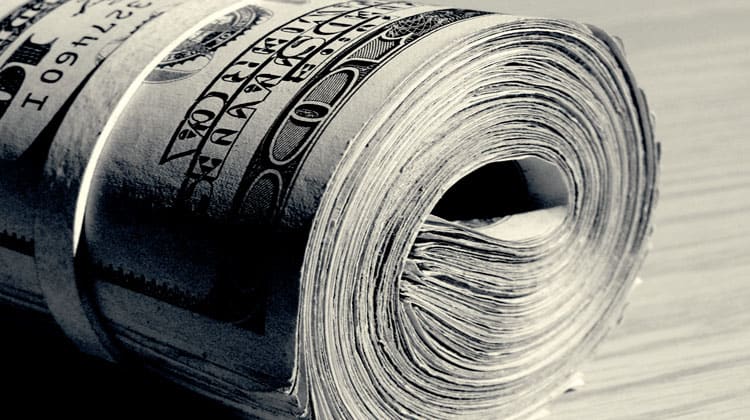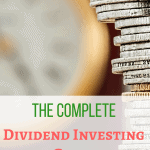THIS POST MAY CONTAIN AFFILIATE LINKS. PLEASE SEE MY DISCLOSURES. FOR MORE INFORMATION.

Well, investing in stocks is exactly the same concept. When you buy a stock, you buy a small part of a really large business. The business spends money to make money and hopefully turns a profit by the end of the year. Part of this profit is paid out to investors in the form of dividends.
For many investors these dividends are absolutely essential. Not only do some investors live off of them, but they also use it as the basis on which the whole company’s value is calculated. This dividend-focused investment strategy is called dividend investing. Here’s everything you need to know about it.
Table of Contents
Your Guide To Dividend Investing
The Source
To understand why dividends are so important it’s essential to learn where they come from. Dividends are linked to the company’s free cash flow. As the name suggests, free cash flow is cash leftover in the company that doesn’t need to be used.
Most companies listed on the stock market earn a cash profit at the end of the year. Management then decides to reinvest part of this cash into the business. Some of the money is used to buy new property, equipment, expand operations, or pay back loans. Once all that is taken care of, the amount left over is either left in a bank account or given to shareholders. After all, the owners of the company (shareholders) deserve to keep this leftover cash.
The Advantages
It’s hard to deny that tangible cash returns are advantageous. Take Google (NASDAQ: GOOG), for example. The tech giant reinvests all its free cash flow back into the business and doesn’t pay a dividend. If you buy a stock of Google you will receive an annual report telling you the company is doing well and making a healthy profit. But you won’t see any of that money till you sell the stock.
On the other hand, you have Coca Cola Co. (KO), which earned $1.37 per share in 2016 and paid out $1.05 in dividends per share over the course of the year. That means the company paid out nearly 77% of what it earned. In fact, KO has been paying a steady, rising dividend every year for the past half century (54 years). It shows no signs of slowing down either.
Consistent and rising dividends are a great sign of the stability and maturity of the company. Companies are reluctant to cut or stop dividends, so their payment schemes tend to be very stable. A healthy yield can actually outperform the fixed rate of interest investors can expect from savings accounts. AT&T (T), for example, yields nearly 5% in dividend, which is much higher than the 2.3% US 10-year Treasury bonds are yielding at the moment. A high dividend-paying stock can act like a combination of a equity and fixed income asset. For income seeking investors that’s excellent.
The Disadvantages
Dividends aren’t a surefire way to get rich. They have certain downsides that must be understood before you can invest in dividend-paying companies.
If you notice, some of the highest dividend payers are slow growing, mature firms. These high dividend companies don’t expect to grow rapidly over the years. They usually operate in stagnant industries with low stock-price appreciation.
Also, the stock price could eat into the dividend yield. If a stock yields 5% in dividends but the price falls 5% that year, your returns have been eliminated. Companies can also choose to cut or stop paying dividends if circumstances changes. When the price of oil collapsed in 2014, many energy companies cut their dividend payouts. Similarly, new management could come in and change the dividend payment plan.
Finally, tax rates on dividends are unpredictable. Right now the tax rate depends on the investor’s income and whether the dividends are qualified. But this could change over the years and have an impact on your performance.
The Strategy
Investing, like going into business, requires a lot of discipline. You need to plan ahead and have the will to persist with a iron-clad strategy.
Dividend investing involves a rather simple, three-step strategy.
Step 1: Find great dividend stocks
A great dividend stock is a company with a high yield and the financial strength to keep paying dividends. Take the time to dig into the S&P 500 Dividend Aristocrats Index and find stocks that yield more than Treasury Bonds and have enough headroom to keep paying dividends over the long term.
Step 2: Value them using DDM
After you’ve narrowed the list to a few select stocks you need to buy them for less than they’re worth. Estimate how much the company is likely to pay in dividends over the long-term and discount these payments back to present value. This present value is the intrinsic value of the stock and you must try to buy it for less. This is called the Dividend Discount Model.
Step 3: Review regularly
Once you’ve created a diversified dividend portfolio, review it regularly to check for any changes in valuation, dividend policy or earnings power. Like a health check up for your portfolio.
Conclusion
Dividend investing is a straightforward strategy that really applies common sense and the power of compounding to make you wealthy. If you apply the three-step strategy mentioned above you’ll end up with a portfolio filled with excellent companies that regularly give back hard cash to shareholders. Don’t expect these companies to grow rapidly or stun the world with a hot new innovation. But if you have the patience to hold them for the long-term they could provide some tremendous returns.
Author Bio: Michelle Custodio is a digital marketing specialist at Dividend Appreciation, a site that gives its readers a clear path to a financially secure income stream from dividend paying stocks.
[Photo Credit: Chris Potter]
I have over 15 years experience in the financial services industry and 20 years investing in the stock market. I have both my undergrad and graduate degrees in Finance, and am FINRA Series 65 licensed and have a Certificate in Financial Planning.
Visit my About Me page to learn more about me and why I am your trusted personal finance expert.

